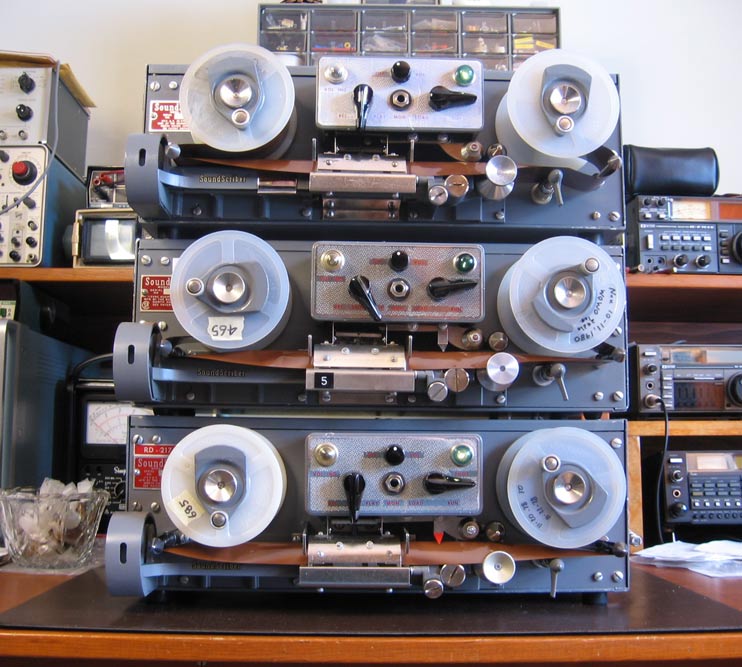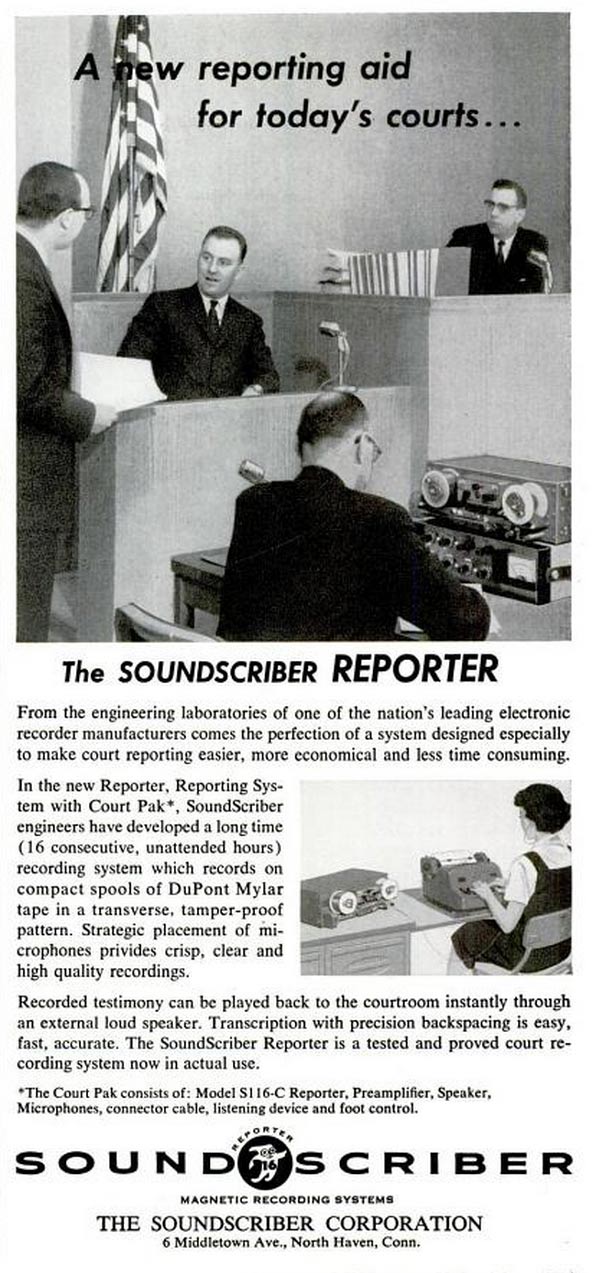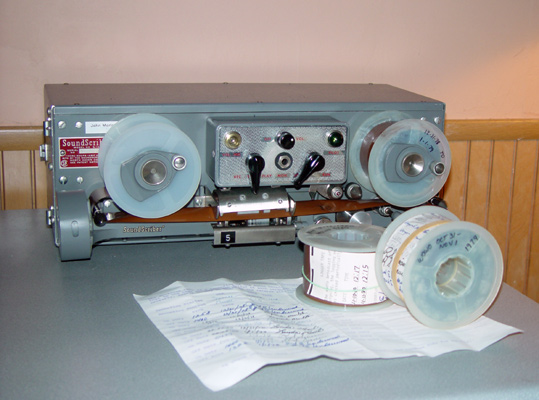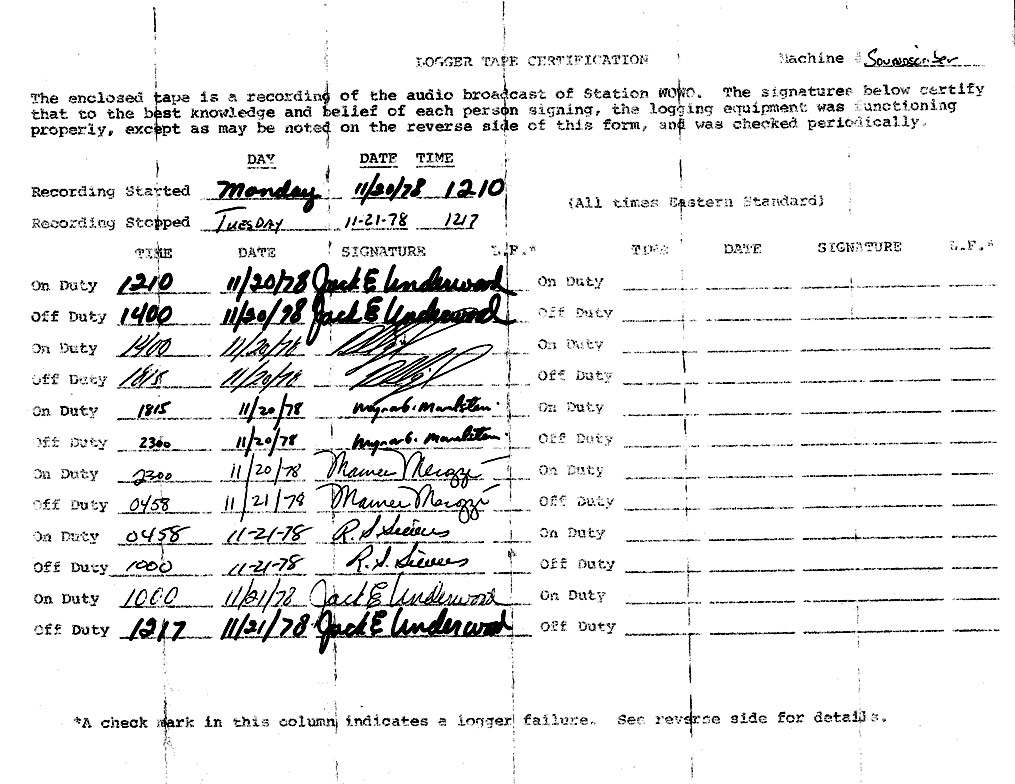We are interested in your comments and suggestions on how we can improve the History of WOWO.com. Click on the Contact Us link at the bottom of this page.
WOWO SoundScriber Project
Most airchecks on this site have been submitted by listeners like you who happened to tape them. However, another invaluable source of historical recordings has been the WOWO SoundScriber Project and it has a rather interesting story behind it:
In August, 2009, Jack Didier, who is WOWO's Chief Engineer, contacted us and made a fascinating offer. He said he had several YEARS of logger tapes at the WOWO transmitter site and had no way to play them, but we could have access to them it we wanted to check them out.
Many large radio stations ran what were called logger tapes for legal reasons. They typically were recorded on specialized, very slow-speed tape machines and were of fairly poor quality. But they could at least verify if a spot was broadcast at the correct time, when a transmitter outage occurred or if a bad word made it on the air.
Our first question to Jack was what type of tapes he had. It turned out be in a format called SoundScriber.
SoundScriber tapes were 2 inches wide and used a pair of spinning heads similar to consumer VCRs. One tape would hold 24 hours of audio, running at just 2.5 inches per MINUTE. (By comparison, a standard audio cassette runs at 1 7/8 inches per SECOND.) The devices were most widely used by governmental agencies to record police and fire radio traffic, phone calls, courtroom proceedings and aircraft radio transmissions. Audio quality of these recordings wasn't great, but for lack of any better technology, radio stations began using them as loggers in the 1950s. It appears that WOWO used SoundScribers for loggers from roughly 1959 until 1981.
WOWO had a total of four SoundScriber S-124 machines, two at the transmitter site and two in Master Control at the main studio location.
We contacted several former WOWO engineers and staffers on the best way to copy these tapes, and the response was unanimous: good luck! No one knew where any working (or non-working) SoundScriber machines might be located. In fact, Google searches uncovered almost no information at all. It seemed to be a dead issue and a darned shame.
Then, about three months later, we received an email from former WOWO Chief Engineer Dave Snyder, who has been a tremendous source of material for HistoryOfWOWO.com. He had located someone with a SoundScriber S-124 (in suburban Fort Wayne, no less)! The owner wanted to get it into complete working condition first, but was willing to loan it to us.
The owner of the SoundScriber turned out to be John Morton. John had been a 19 year-old boy wonder who worked as a vacation-relief transmitter tech at WOWO in the summer of 1973, right after he had received his First Class FCC license. In 1977, a friend invited John to take a look at some gear being discarded by the Fort Wayne Emergency Communications Department. Among the items, John recognized the somewhat obscure SoundScriber machine and saved it from the landfill, not knowing what he would do with it. It sat in storage for more than 30 years.
With no service manual or even a schematic, John spent many hours restoring the unit to like-new condition in November 2009. He generously has trusted us with it, on indefinite loan for this project.
And finally, back to the WOWO tapes themselves: Jack had several hundred tapes stored in the bomb shelter at the transmitter site. These tapes were recorded on the SoundScriber S-124s at the Central Building studios in downtown Fort Wayne. They spanned a period of roughly three years, from fall 1978 to 1981. Tapes prior to 1978 were likely either reused, or thrown into a dumpster during a move. Each tape included a certification sheet with the signature of each air personality or board operator on duty, with the time they started and ended their shift.
According to Dave Snyder, "The Soundscriber tapes were the actual legal program log. The paper log could be reconstructed from the tape, thus the signature sheet that was with each tape. The legal requirement for retention was two years and the station had 700+ reels for that. About 1973 we bought a couple of hundred more reels used. Some were empty and some did not have a full 25 hours. I filled wastebaskets of old tape. We got a stack of videotapes from the Philadelphia dub center and I filled hundreds of reels with 25 hours of Soundscriber tapes. Group W produced several programs that were syndicated and bicycled around the country and so they used lots of quad tape. The original (older) tapes had red oxide and the ones I filled had black oxide."
We borrowed a few dozen of these surviving tapes from Jack Didier, mostly just randomly chosen dates. The final question was whether the tapes were playable at all after more than 30 years.
Now for the best part: It turned out that they were indeed playable and the audio quality was fairly decent, although quality does vary from tape to tape.
The final discussion was whether to edit the final versions of these recordings to remove the music. The music quality is marginal, since the SoundScriber was designed primarily to record voice. There was no genuine consensus on this; but we finally decided that the unedited recordings were genuine historical artifacts and that it is fairly easy to skip through them if you like.
The beauty of these logger tapes is that unlike most airchecks, they contain complete recordings of the station, including all commercials and newscasts. They are unique historical snapshots of not just WOWO, but of Fort Wayne and America.
Dubbing these tapes hour-by-hour is a very time-consuming process. We already have more than 15 hours of them posted on the airchecks page, but it will take months and months to post all the tapes we borrowed from WOWO's archives. In addition, we have begun to hear of the existence of even earlier WOWO SoundScriber tapes that we may have access to, so stay tuned!! We hope the effort is worth it and we certainly hope you enjoy them!
UPDATE, 12/31/10
In September 2010, we acquired TWO additional Soundscriber S-124 machines for the Soundscriber Project, from a seller in Wisconsin. He had purchased the contents of a storage locker and they were among the items insid e. Neither machine would even power up.
e. Neither machine would even power up.
One had a plate that said RD 217/UNH, which was a version produced for the US Navy. Based on the internal components, it appears that one was manufactured in 1959, the other in 1961. Other than that, the history of these machines is unknown.
John Morton spent nearly three months tracking down literally dozens of parts and lovingly rebuilding these two machines to like-new condition. (In fact, BETTER than new--he discovered a wiring error in one of the machines, apparently made at the factory!)
So, (counting the original unit loaned to us by John) we now know of three Soundscriber machines in good working order!
Not bad, considering a little over a year ago, we had little hope of finding even one!




